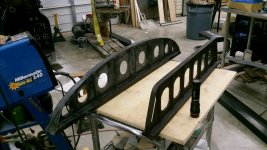swatkins
Titanium
- Joined
- Jul 24, 2011
- Location
- Navasota / Whitehall Texas
Since I've gotten the planer going I've been planing a lot of straight edges, some of my own and some work for others. Today I was getting a couple of edges ready for the planer.


The one on the left is an unknown brand 48" and the right one is a 36" King Way. While only 12 inches longer the unknown brand weighs at least three times what the King Way does. The King Way tipped the scales at 28 lbs and while I did not have a scale large enough for the 48" I conservatively estimate it at least three times heavier.
Just moving that 48" one is a PITA!
I started studying both edges looking for why there was such a huge difference in weight. On the 48" every feature was at least 2 or three times the size of the King way. Now if I did not know the history of the King Way ( They have been made and sold by the King's for a long, long time) I would have just passed the light edge off as a cheap way to make the item and probably a product of China...
Obviously the King Way has been in use for a long time and has a proven record or we would have been hearing about it. I have two 24" King Ways and they both have the same features of the 36", tall backbone, large lighting holes and long thin ribs.. One is a dovetail and has a thicker base to accommodate ( I think) the area needed for the dovetail side but even then it is light enough to use with ease..
One difference I noted was the design of the back. The 48" has a curve that tapers down evenly to the ends while the King Way has a "trestle" design that brings the supporting back closer to the ends of the edge. Am I right in thinking this design allows a lighter yet stable tool?


The one on the left is an unknown brand 48" and the right one is a 36" King Way. While only 12 inches longer the unknown brand weighs at least three times what the King Way does. The King Way tipped the scales at 28 lbs and while I did not have a scale large enough for the 48" I conservatively estimate it at least three times heavier.
Just moving that 48" one is a PITA!
I started studying both edges looking for why there was such a huge difference in weight. On the 48" every feature was at least 2 or three times the size of the King way. Now if I did not know the history of the King Way ( They have been made and sold by the King's for a long, long time) I would have just passed the light edge off as a cheap way to make the item and probably a product of China...
Obviously the King Way has been in use for a long time and has a proven record or we would have been hearing about it. I have two 24" King Ways and they both have the same features of the 36", tall backbone, large lighting holes and long thin ribs.. One is a dovetail and has a thicker base to accommodate ( I think) the area needed for the dovetail side but even then it is light enough to use with ease..
One difference I noted was the design of the back. The 48" has a curve that tapers down evenly to the ends while the King Way has a "trestle" design that brings the supporting back closer to the ends of the edge. Am I right in thinking this design allows a lighter yet stable tool?


![20170402_115649[1].jpg 20170402_115649[1].jpg](https://www.practicalmachinist.com/forum/data/attachments/164/164793-d68d369dbb32546b5061ca9e847d1ab1.jpg)

 . I'd be interested what somebody experienced in using them might see as sufficient strength/stiffness conditions. One thing I learned ( or rather had confirmed ) is that too light and thermal issues creep in big time - those are difficult to control if one wants a product easy to cast.
. I'd be interested what somebody experienced in using them might see as sufficient strength/stiffness conditions. One thing I learned ( or rather had confirmed ) is that too light and thermal issues creep in big time - those are difficult to control if one wants a product easy to cast.